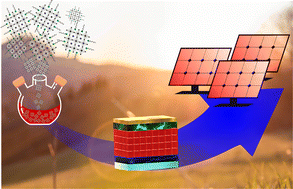Tiny spots to light the future: advances in synthesis, properties, and application of perovskite nanocrystals in solar cells
Abstract
Perovskites are in the hotspot of material science and technology. Outstanding properties have been discovered, fundamental mechanisms of defect formation and degradation elucidated, and applications in a wide variety of optoelectronic devices demonstrated. Advances through adjusting the bulk-perovskite composition, as well as the integration of layered and nanostructured perovskites in the devices, allowed improvement in performance and stability. Recently, efforts have been devoted to investigating the effects of quantum confinement in perovskite nanocrystals (PNCs) aiming to fabricate optoelectronic devices based solely on these nanoparticles. In general, the applications are focused on light-emitting diodes, especially because of the high color purity and high fluorescence quantum yield obtained in PNCs. Likewise, they present important characteristics featured for photovoltaic applications, highlighting the possibility of stabilizing photoactive phases that are unstable in their bulk analog, the fine control of the bandgap through size change, low defect density, and compatibility with large-scale deposition techniques. Despite the progress made in the last years towards the improvement in the performance and stability of PNCs-based solar cells, their efficiency is still much lower than that obtained with bulk perovskite, and discussions about upscaling of this technology are scarce. In light of this, we address in this review recent routes towards efficiency improvement and the up-scaling of PNC solar cells, emphasizing synthesis management and strategies for solar cell fabrication.

- This article is part of the themed collections: Recent Review Articles and Halide Perovskite Optoelectronics


 Please wait while we load your content...
Please wait while we load your content...